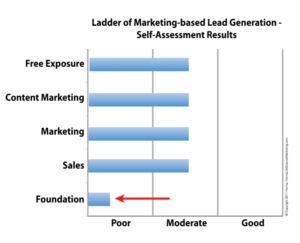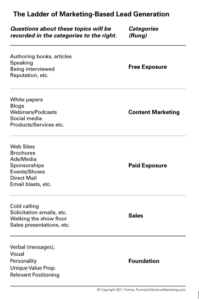Marketing-based Lead Generation in the Biological Sciences (Part 5)
By David Chapin
SUMMARY
VOLUME 3
, NUMER 4
In this issue we give you access to a tool you can use to assess your own marketing-based lead-generation efforts. Take 10 minutes to answer some short and simple yes-no questions about your brand and you’ll receive valuable feedback on your lead-generating efforts. We’ll also look at common patterns in the responses.
Part 5: Assessing your own marketing-based lead-generation efforts
Assessing your own performance on the Ladder of Marketing-based Lead Generation for Life science, Biotech and Med-device Companies
We’ve spent a lot of time on lead generation in recent issues of this newsletter. I’ve reviewed both the theory and the practice of lead generation and I’ve provided many tips for optimizing your own lead-generating activities.
How effective is your portfolio of lead-generating activities? I know that the ladder of lead generation for life science, biotech and med device companies, with all its moving parts, can seem overwhelming. Some of you may be saying, “Oh, there’s just so much to do, I can’t even (or don’t know where to) begin.” A Chinese proverb is appropriate here: “A journey of a thousand miles starts with a single step.“ It is better to focus on incremental improvement, however slow, than risk being overwhelmed and make no progress at all. Maybe you’ve already taken a couple of small steps toward improving your ladder of lead generation by implementing one or two suggestions from past issues of this newsletter. After attending to those issues, you can move on to others – ultimately achieving a robust lead-generating portfolio.
To help you with your efforts, and to provide you with a method to track your progress, I’m going to give you a pop quiz; this will be a good way to bring to a close our examination of the ladder of marketing-based lead generation for life science, biotech and med-device companies. For those readers outside the US that may not be familiar with the term, a pop quiz is a short assessment, given without warning. It is not as comprehensive as a traditional test, and it is designed to be taken – and graded – quickly.
In this case, rather than testing your theoretical knowledge, the quiz serves as an assessment tool by which you can evaluate the performance of your lead-generation efforts. In other words, it’s not testing you; it’s testing your marketing-based lead generation efforts.
Your marketing blood pressure
A medical analogy is apt in this case: When a patient visits a doctor, one of the first things that happens is the measurement of four key data points – sometimes known as the “big four:” pulse rate, blood pressure, respiration rate and body temperature. With these in hand, clinicians have crucial information about the general state of a patient’s health and are given some hints about where to focus further attention.
Like measuring the “big four,” this marketing assessment is simple and quick; it consists of 50 yes/no questions. You should be able to complete it in 10 minutes or less and you shouldn’t have to think too hard to answer each question. When you are finished answering the questions, you will be given some feedback on the overall health of your lead-generation efforts. The link to the test is here. You can go take it now or you can read through to the end of this newsletter, where there will be another link.
Two uses for this lead-generation self-assessment
There are two ways you can use this assessment.
- Take the assessment and use it as a guide to address the issues it brings to light. Then take the assessment some time in the future – say three to four months from now. After all, regular assessments of progress have been shown to be effective in prompting improvement in most goal-oriented activities.
- In addition to completing it yourself, give this assessment to a colleague. Comparing answers and your overall scores can be instructive. Different interpretations of your situation might shed light on where should you be focusing your efforts as you seek to improve your lead-generating activities.
Three caveats
Because this self-assessment consists of only 50 questions, and because it covers the entire ladder of lead generation, allow me to point out a few caveats.
1) This is a high-level assessment. It is not designed to assess your organization’s performance in each activity on every rung of the marketing-based ladder of lead-generation. In only fifty questions, we won’t be able to assess your performance in every best-in-class technique for improving your website, your tradeshow booth, your content marketing, your messaging, your positioning – just to name a few. Rather than examine the fine details, this quiz is intended to assess your efforts at a higher level. In other words, are your lead-generation efforts on-target in terms of the big, important factors?
2) It is important that your lead generating activities be well balanced. Your score should reflect this, with similar scores for each rung on the ladder of lead generation. This is reflected in the number of questions that we ask about the different lead generating activities, as shown in figure 1.
Figure 1: The number of questions asked about each type of lead generating activity are shown here. The point of this figure is that the balance is fairly even among all the questions asked. This reflects our view that a properly balanced ladder of lead generation will be most effective in driving a steady stream on high quality inbound inquiries. Of course, each organization’s situation in each business sector will vary.
3) This assessment represents our view of the challenges of marketing in the life sciences – not direct-to-consumer or retail marketing. Because we specialize in this field we have seen many challenges reoccur over the years. There are some marketing challenges that many life science companies handle poorly, and we’ve tried to include these by asking some targeted and specific questions.
Interpreting the results of your lead generation assessment
After answering all the questions, your responses will be scored and presented in a graph – a depiction of the strength of your activities on the various rungs of the ladder of marketing-based lead generation for life science, biotech and med device companies. As shown in figure 2, responses to individual questions will be combined into scores for each of the following rungs: Foundation, Sales, Marketing, Content Marketing and Free Exposure. If your responses reveal that your activities on a particular rung on the ladder of lead generation are effective, you will have a long answer bar on that rung. If not, your answer bar will be short.
Figure 2: The ladder of lead generation is shown here, with the categories in which your answers will appear.
Common patterns in the assessment
There are several common patterns in these response charts; we’ll look at a few – one at a time. We’ll examine briefly the factors that might give rise to these patterns of scores, and we’ll talk about the marketing implications if the issues are not corrected.
A weak foundation
If your lead-generation scoring sheet looks like that shown in figure 3, then your fundamentals (consisting of your positioning, your messaging and your brand) are weak.

Figure 3: Regardless of a firm’s performance on other rungs, firms with a weak foundation typically have trouble in all subsequent lead-generation efforts. These firms are seen by their customers as undifferentiated (that is, highly commoditized), and they probably face significant pricing pressure.
In general, there are two types of firms that might have a weak foundation. The following descriptions are general, so your situation may not match exactly. All the same, if your foundation score is weak, are there any similarities between your situation and the two types of firms described here?
First are firms that don’t know any better. They don’t have a written statement of their positioning because they don’t understand or care about the importance of a strong competitive position. Their positioning isn’t truly unique – or even clear – and this affects all subsequent lead-generating activities, from their messages through their brochures, email marketing, trade show booths, web sites, etc.
Second are firms that understand the importance of a strong position and a strong brand, but haven’t done the hard work of 1) defining, testing and documenting a truly unique position and 2) articulating this position through a well-designed set of brand messages and a strong brand image.
The firms with low scores on their foundation also tend to have low scores on the two highest rungs (content marketing and free exposure) because both depend upon a unique position and a strong point of view.
Marketing implications: Firms with a weak foundation will face stiff competition. Without a unique position, they find themselves competing on meaningless differences, or on price. These firms may face significant pricing pressure, because their clients will see them as simply suppliers, rather than partners or solutions providers.
Addressing the situation: To address this situation, you must define, test and document a truly unique position – one that is clear, unique, authentic, sustainable, important, believeable and compelling. You must then use this position to drive your marketing, starting by articulating it through a well-designed set of brand messages and a strong brand image. For more information on positioning, click here
Weak at the top
If your lead-generation scoring sheet looks like figure 4, then your lead-generating engine is working, but may not be firing on all cylinders.
Figure 4: Regardless of a firm’s performance on other rungs, firms with weak lead-generating activities in content marketing and free exposure will have to work hard for their leads.
Marketing implications: For firms with weak top rungs, there may be some evidence that sales are being awarded to better-known competitors, who in some cases may even be less capable of fulfilling the buyer’s needs. There may be internal talk of the need for “building brand awareness” and for getting on more “short lists” of potential customers. There may also be a sense that your organization has the capability to handle larger and more significant orders/projects than you are currently getting.
Addressing the situation: If you score poorly on your top rungs, your marketing needs a boost, in the form of increased visibility and a growing reputation. To begin, make it easier for prospects to find you by implementing a robust content-marketing initiative. To be effective, the content you generate must be truly unique, educational in tone (not sales-oriented) and free. The content must be developed and disseminated in a steady stream and made readily available (by posting to your web site and by promoting through social media channels, among other means). This content should also form the basis for a larger search engine optimization initiative. For more on content marketing, see this link.
While you may be able to outsource the development of your content in the short term, in the long run this content should be generated “organically” from within your firm. You may hire outside resources (editors, producers) to help polish and produce the content, but the ultimate goal is to author the content within your own firm, drawing on your unique pool of knowledge and experience.
Once you create a steady stream of content, it is time to harness social media and the press to promote your efforts. As these build on themselves, you can augment them by cultivating relationships with editors in trade publications and producers of conferences and symposia.
Strong at the top and bottom
If you have a good foundation (a strong positioning/messaging/brand score as shown in Figure 5), and a high score on content marketing, then your marketing-based ladder of lead generation should be producing a steady stream of high quality, late-stage (ready to buy) leads.
Figure 5: Regardless of their performance on the rungs of Marketing and Sales, firms with a strong foundation, strong content marketing and strong free exposure are in an enviable position. Their ladder of lead generation typically generates a strong flow of inbound leads.
Marketing implications: With a strong (unique and relevant) position, your brand represents something that has true value to customers. By appearing on the podium, by being quoted in the national press, by writing articles for trade publications and by generating a steady stream of compelling content, your unique point of view benefits from wide circulation. Your ladder of lead generation will be working well, and you will need to rely less on outbound solicitation and traditional marketing tactics to develop leads. This may even translate into lower costs for the activities in the center of the ladder and a greater emphasis on response to inbound leads than outbound lead generation.
Conclusion
Using the linked assessment to determine how your score on the ladder of lead generation changes over time is a good way to track your progress and to identify potential deficiencies in your lead-generation efforts and areas that need your attention.
When it comes to addressing any deficiencies in your lead-generating activities, allow me to repeat that it is better to focus on incremental improvement, however slow, than to make no progress at all.
Lead generation is a complex subject with many moving parts. I welcome your feedback or questions about this topic. If you want to take the assessment, click here.
Summary
- Use the web-based assessment tool to determine your firm’s score on each rung of the marketing-based ladder of lead generation.
- When it comes to addressing the shortcomings in your ladder of lead generation, it is better to focus on incremental improvement, however slow, than risk being overwhelmed and make no progress.
- This is a high-level assessment that can help you determine whether your firm has the important aspects correct.
- It is important that your lead-generating activities be well-balanced – unless you are one of those rare firms that score well both at the top and the bottom of the ladder.
- There are several possible patterns that might appear in your firm’s answers. Your results may or may not match these, but here are some patterns to watch out for:
- A weak foundation. This typically results in commoditization and price pressure. Fix this by working on your positioning, your messages and your brand.
- A weak top. This typically results in a lack of brand awareness. Fix this by working first on content marketing and then on social media and PR.
- A strong foundation and top. This beneficial situation is rare, and in some circumstances can result in a reduced need for emphasis and expenditures in the middle of the ladder.
The Marketing of Science is published by Forma Life Science Marketing approximately ten times per year. To subscribe to this free publication, email us at info@formalifesciencemarketing.com.
David Chapin is author of the book “The Marketing of Science: Making the Complex Compelling,” available now from Rockbench Press and on Amazon. He was named Best Consultant in the inaugural 2013 BDO Triangle Life Science Awards. David serves on the board of NCBio.
David has a Bachelor’s degree in Physics from Swarthmore College and a Master’s degree in Design from NC State University. He is the named inventor on more than forty patents in the US and abroad. His work has been recognized by AIGA, and featured in publications such as the Harvard Business Review, ID magazine, Print magazine, Design News magazine and Medical Marketing and Media. David has authored articles published by Life Science Leader, Impact, and PharmaExec magazines and MedAd News. He has taught at the Kenan-Flagler Business School at UNC-Chapel Hill and at the College of Design at NC State University. He has lectured and presented to numerous groups about various topics in marketing.
Forma Life Science Marketing is a leading marketing firm for life science, companies. Forma works with life science organizations to increase marketing effectiveness and drive revenue, differentiate organizations, focus their messages and align their employee teams. Forma distills and communicates complex messages into compelling communications; we make the complex compelling.
© 2024 Forma Life Science Marketing, Inc. All rights reserved. No part of this document may be reproduced or transmitted without obtaining written permission from Forma Life Science Marketing.



